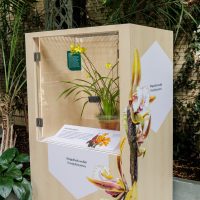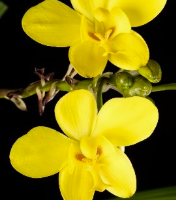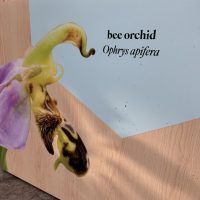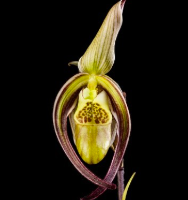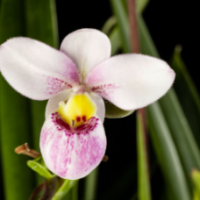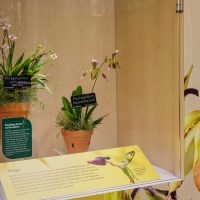Deceit: A deadly sin or necessary survival adaptation?
A deadly sin or necessary survival adaptation? Deceit is the subject of this year’s annual orchid exhibition, hosted in the conservatory at the U.S. Botanic Garden. “Orchids: Masters of Deception” explores and celebrates the unique ways the Orchidaceae family employs deception to survive in nature. And for plants this beautiful, it doesn’t seem so bad to be dishonest.

The entrance to the joint Smithsonian-U.S. Botanical Gardens exhibition, “Orchids: Masters of Disguise.” (Photo by Hannele Lahti)
As you enter, you might initially think you’re seeing double, but the pair of identical pergolas are individually dedicated to one of two collections populating the exhibit: Smithsonian Gardens Orchid Collection (SGOC) and US Botanic Garden (USBG). This is the 29th collaboration between Smithsonian Gardens and USBG, a successful partnership that expands the diversity of orchids on view and allows the exhibit to stay up for three months by rotating plants and sharing resources. Between the two collections, “Masters of Deception” features thousands of orchids.
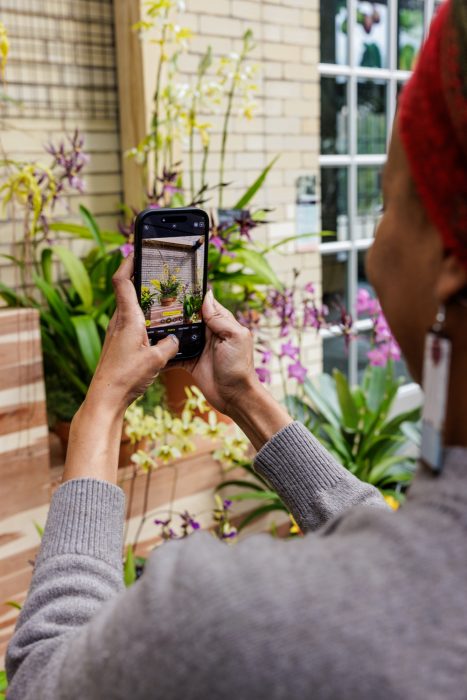
A visitor takes a close-up of one of the orchids on display in “Masters of Deception.” (Photo by Hannele Lahti)
Marisa Scalera, a landscape architect who worked on the exhibit this year, emphasized that the thousands of unique specimens on view do more than create a beautiful display. Scalera says both the Smithsonian and US Botanic Garden collections “are vital conservation resources that protect the species from various threats, including habitat change and overcollecting.” The exhibit’s opening dual structure is a tribute to decades of joint work protecting this vital species and the collaboration that makes each orchid exhibit possible.
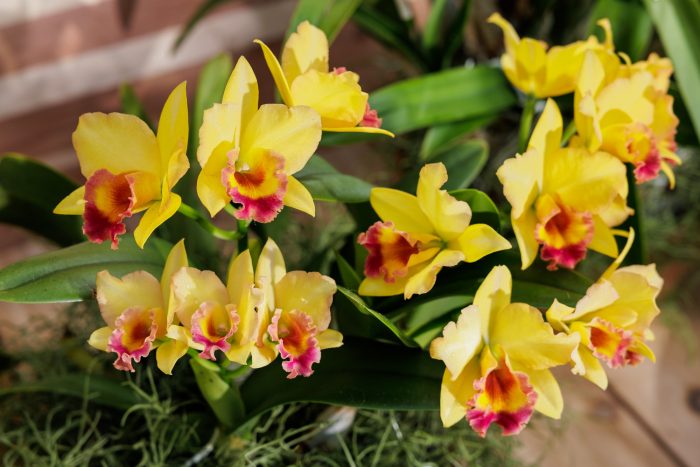
The Smithsonian Sunburst orchid from the collections of Smithsonian Gardens. (Photo by Hannele Lahti)
Learn more about the North American Orchid Conservation Center, established by the Smithsonian and USBG, to protect and preserve native orchid species here.
Throughout the rest of the exhibit, four cases introduce and explain one of the primary modes of deception for orchids—food, sexual, brood-sites and traps.
Tsk. Naughty orchids!
Food deception details how some orchid flowers mimic the smell, shape or color of pollinators’ food sources, while being completely nectarless. Seen in the case, the Spathoglottis kimballiana, a species native to the Philippines, exemplifies this type of orchid with bright yellow blooms that imitate nectar-rich sources. The pollinator ultimately receives no nourishment but leaves a desirable trail of pollen for the orchid as it attempts to forage.
- A display case explains how some orchids mimic food sources in order to lure pollinators. (Photo by Sophia Ancira)
- Close-up of the yellow blooms of a Spathoglottis Kimbal liana orchid from the Smithsonian Gardens orchid collection.
Similarly, sexual deception involves an orchid’s flowers mimicking physical attributes of female pollinators—such as smell, shape and color—to entice male pollinators. The blooms bear such a convincing resemblance that male pollinators attempt to mate with the flower, unwittingly transferring pollen to the plant (ensuring its fertilization) without any success in mating. Alongside some live collection examples, a close-up of the bee orchid on the display case illustrates just how well an orchid can replicate female pollinators’ appeal.
- The bee orchid uses sexual deception to tempt pollinators. (Photo by Sophia Ancira)
- Close-up of the Phragmipedium pearcei ‘Birchwood.’ (Photo by Hannele Lahti)
Some orchid species recreate the appearance and even smell of a site where pollinators might lay their eggs in an act of brood-site deception. This is a less common form of deception and can even include the blooms emitting a foul odor (at least, by our standards) to attract female flies. The ‘Birchwood’ orchid currently on view is from the Smithsonian Gardens Orchid Collection. It lures in female hoverflies by imitating an aphid-infestation, tricking the hoverfly into pollinating the plant as she searches for a spot to lay her eggs.
- Close up of Phragmipedium schlimii ‘White Star’ bloom from the Smithsonian Gardens Orchid Collection.
- A display case explains how many orchids use deceptive techniques or “traps” to improve their chances of survival. (Photo by Sophia Ancira)
And lastly, trapsare the species’ most complex form of deception. The flower ensnares pollinators—sometimes for seconds and sometimes for days. Once trapped, the pollinator or insect picks up or deposits pollen as it searches for an escape, ensuring the orchid is fertilized. Currently on view, the Phragmipedium schlimii (‘White Star’) has a pouch-like flower petal that allows for easy access but creates a difficult escape.
However, this orchid species is critically endangered in its natural habitats in Ecuador and Colombia. By showcasing endangered orchids like Phragmipedium schlimii, the orchid exhibit shines a light on the importance of conservation work being done at Smithsonian Gardens and the US Botanic Garden, as well as the need to continued efforts and public education.
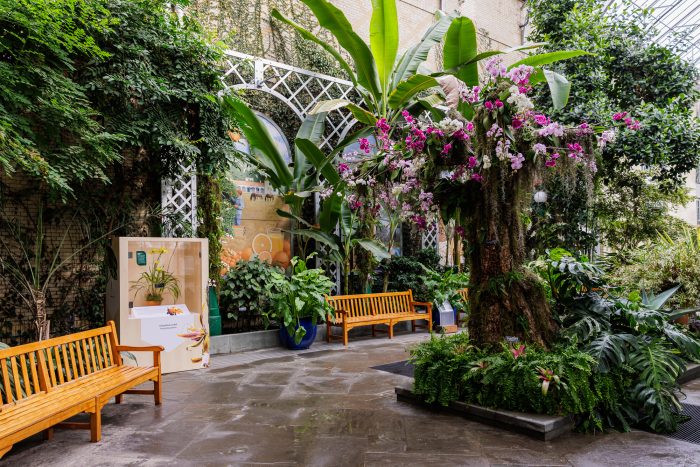
A grove of “trees” rival blooming cherry trees with lavish displays of Phalaenopsis orchids. (Photo by Hannele Lahti)
Even outside these natural forms of deception, orchids are transformed into masters of disguise at either end of the conservatory. Masquerading as one of D.C.’s most notable blooming plants, two 9-foot-tall cherry blossom trees are recreated with Phalaenopsis orchids in pastel pinks, deep magentas, and milky whites. The 22 lamps lining the conservatory’s main path are wrapped with orchids, almost entirely hidden behind mossy lining and colorful blooms of orchids such as Oncostelopsis Brazilian Sun ‘Samba’ and Oncidium Sweet Sugar ‘Lemon Drop.’

Orchid ‘Samba’ covering a lamppost. (Photo by Sophia Ancira)
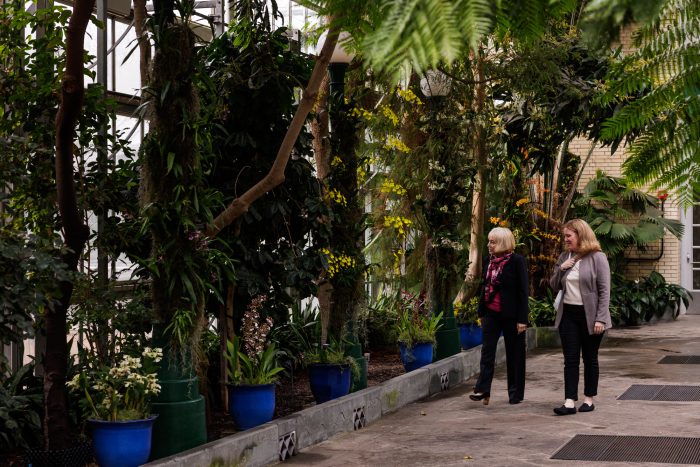
Don’t let their beauty fool you. There is so much more to this species than aesthetics. Visit “Orchids: Masters of Deception” until April 27, between 10 a.m. and 5 p.m. daily. To ensure the health of the plants and showcase peak blooms, the USBG and Smithsonian Gardens teams will rotate the display regularly, meaning each trip will be an opportunity to see something new.
But wait, there’s more! Check out some of these beauties from our collections.
Posted: 20 March 2025
-
Categories:
Education, Access & Outreach , Feature Stories , Science and Nature
